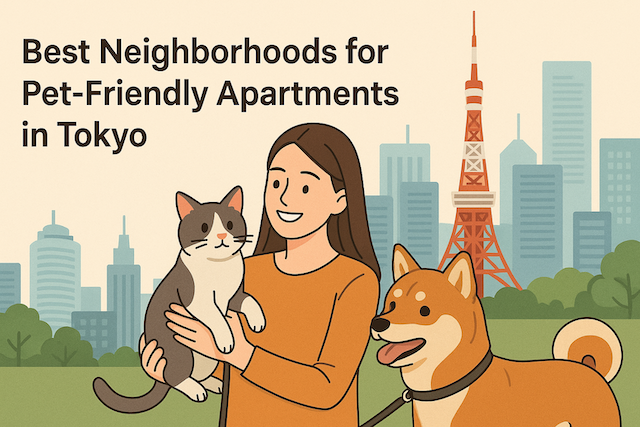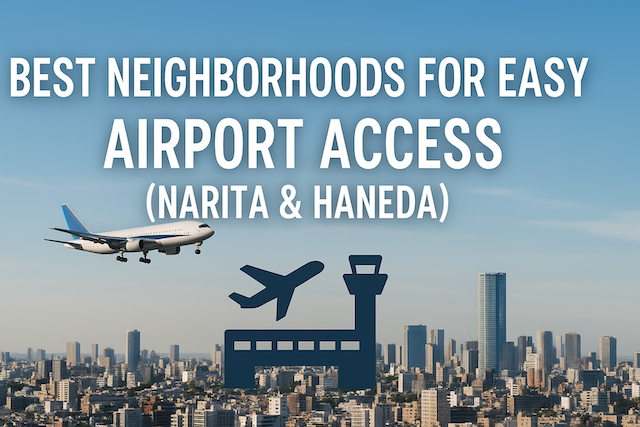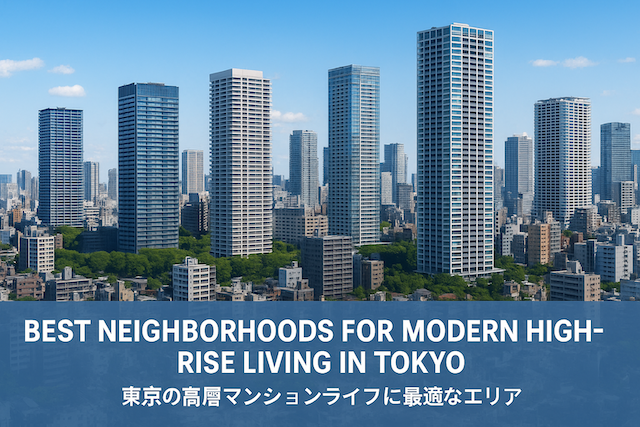Best Neighborhoods Near Shibuya Station
Shibuya is one of Tokyo’s most dynamic and iconic districts — a hub of youth culture, fashion, entertainment, and innovation. Known for the famous Shibuya Crossing, this neighborhood is constantly buzzing with life. Yet, beyond the neon lights and department stores, there are many surrounding areas that offer different living styles — from quiet, tree-lined streets to trendsetting residential zones.
If you’re planning to move near Shibuya Station or simply want to know which nearby neighborhoods suit your lifestyle, this guide introduces the best neighborhoods near Shibuya Station with insights into accessibility, atmosphere, and rental trends.
Shibuya: The Heart of Modern Tokyo
Living directly in Shibuya means being in the middle of everything — fashion, nightlife, shopping, and public transportation. Shibuya Station connects multiple major train lines, including JR Yamanote Line, Ginza Line, Hanzomon Line, Fukutoshin Line, and Keio Inokashira Line.
Lifestyle and Ambiance
Shibuya is ideal for young professionals, entrepreneurs, and creatives. It offers 24/7 convenience, international restaurants, and coworking spaces like WeWork and Plug and Play Shibuya. However, it’s also crowded and expensive, so many people prefer nearby neighborhoods for more comfort and quiet.
Rent Range
-
1R/1K Apartments: ¥130,000–¥180,000/month
-
1LDK: ¥200,000–¥280,000/month
-
2LDK or larger: ¥300,000–¥450,000/month
If you want to experience the pulse of Tokyo, Shibuya itself remains unmatched — but be prepared for high living costs and limited space.
Daikanyama: Stylish and Sophisticated
Located just one stop from Shibuya Station on the Tokyu Toyoko Line (or a 15-minute walk), Daikanyama is often described as Tokyo’s version of SoHo or Brooklyn.
Lifestyle and Ambiance
Daikanyama blends urban luxury with relaxed sophistication. You’ll find boutique stores, trendy cafés, art galleries, and lifestyle concept shops like T-Site Daikanyama (Tsutaya Books). The neighborhood attracts expats, designers, and professionals who enjoy stylish living without chaos.
Why Live Here
-
Calm, walkable streets with European vibes
-
Excellent cafés and brunch spots
-
Popular with foreign residents and families
Rent Range
-
1R/1K: ¥140,000–¥190,000/month
-
1LDK: ¥220,000–¥300,000/month
-
2LDK: ¥350,000–¥500,000/month
Daikanyama offers comfort and elegance near Shibuya — perfect for those who want balance between convenience and tranquility.
Ebisu: Trendy and Convenient
Ebisu is another upscale neighborhood within walking distance or one train stop from Shibuya. Known for its refined atmosphere, Ebisu offers excellent dining, shopping, and easy access to both Shibuya and Meguro.
Lifestyle and Ambiance
Ebisu feels modern yet comfortable. It’s known for Yebisu Garden Place, a complex with restaurants, a museum, and scenic evening views. It’s a great area for couples or professionals who value convenience and sophistication.
Why Live Here
-
Direct access to JR Yamanote Line and Hibiya Line
-
Countless dining and bar options
-
Safe and clean streets
Rent Range
-
1R/1K: ¥130,000–¥170,000/month
-
1LDK: ¥200,000–¥260,000/month
-
2LDK: ¥320,000–¥420,000/month
Ebisu’s mix of accessibility and lifestyle quality makes it one of Tokyo’s most desirable neighborhoods.
Nakameguro: Riverfront Charm and Creative Energy
Just two stops from Shibuya on the Tokyu Toyoko Line, Nakameguro is famous for the scenic Meguro River, lined with cherry blossom trees and stylish boutiques.
Lifestyle and Ambiance
Nakameguro has a distinctly bohemian feel. It’s ideal for artists, freelancers, and those who appreciate café culture and local design. During spring, cherry blossoms create one of Tokyo’s most beautiful views.
Why Live Here
-
Relaxed, artsy community
-
Popular restaurants like Starbucks Reserve Roastery Tokyo
-
Easy access to both Shibuya and Daikanyama
Rent Range
-
1R/1K: ¥120,000–¥160,000/month
-
1LDK: ¥190,000–¥250,000/month
-
2LDK: ¥300,000–¥400,000/month
Nakameguro offers a perfect mix of creativity and calm, making it one of the most livable neighborhoods near Shibuya.
Aoyama: Luxury and Design
Minami-Aoyama and Kita-Aoyama are located just east of Shibuya, accessible via Omotesando or Gaienmae stations. The area is synonymous with luxury brands, contemporary architecture, and elegant living.
Lifestyle and Ambiance
Aoyama is home to flagship stores like Prada, Comme des Garçons, and Issey Miyake. The streets are clean and lined with trees, giving the neighborhood a refined European touch.
Why Live Here
-
High-end lifestyle and international appeal
-
Close to Omotesando, Harajuku, and Roppongi
-
Great for diplomats and executives
Rent Range
-
1R/1K: ¥150,000–¥200,000/month
-
1LDK: ¥250,000–¥350,000/month
-
2LDK: ¥400,000–¥600,000/month
Aoyama is for those seeking quiet luxury near Tokyo’s trendiest hubs.
Omotesando: Tokyo’s Fashion Boulevard
Omotesando, just one stop or a 15-minute walk from Shibuya, is one of Tokyo’s most elegant shopping streets.
Lifestyle and Ambiance
Designed by renowned architects, Omotesando features flagship stores, tree-lined avenues, and chic cafés. The area balances luxury shopping with stylish residential streets hidden behind the main road.
Why Live Here
-
Prestigious address in central Tokyo
-
Perfect for fashion lovers and urban professionals
-
Convenient access to multiple subway lines
Rent Range
-
1R/1K: ¥150,000–¥180,000/month
-
1LDK: ¥230,000–¥320,000/month
-
2LDK: ¥350,000–¥480,000/month
Living in Omotesando means being at the intersection of art, fashion, and design — ideal for those who value aesthetics and convenience.
Hiroo: International and Family-Friendly
A bit farther (two stops from Shibuya via Hibiya Line), Hiroo is known for its embassies, international schools, and a large expat community.
Lifestyle and Ambiance
Hiroo offers a relaxed, residential atmosphere with an international flair. You’ll find global supermarkets, bilingual clinics, and cafés popular among foreigners. It’s quieter than Shibuya but still central.
Why Live Here
-
International schools and services
-
Spacious apartments compared to Shibuya
-
Excellent for families and diplomats
Rent Range
-
1R/1K: ¥130,000–¥170,000/month
-
1LDK: ¥220,000–¥300,000/month
-
2LDK: ¥350,000–¥500,000/month
Hiroo is one of the top choices for families and expats seeking a calm yet connected lifestyle near Shibuya.
Meguro: Green and Residential
Located southwest of Shibuya, Meguro is only 5 minutes away by train. It’s known for its leafy streets, relaxed environment, and high-quality residential areas.
Lifestyle and Ambiance
Meguro combines urban access with suburban peace. The Meguro River and nearby parks make it popular among nature lovers and pet owners.
Why Live Here
-
Comfortable, family-friendly environment
-
Excellent cafés and bakeries
-
Short commute to Shibuya and Ebisu
Rent Range
-
1R/1K: ¥120,000–¥150,000/month
-
1LDK: ¥180,000–¥250,000/month
-
2LDK: ¥280,000–¥380,000/month
Meguro is ideal for those who want balance — close to the city but peaceful enough for long-term living.
Yoyogi and Yoyogi-Uehara: Green, Calm, and Connected
North of Shibuya lies Yoyogi, famous for Yoyogi Park, one of Tokyo’s largest green spaces. The area stretches toward Yoyogi-Uehara, known for its upscale residential charm.
Lifestyle and Ambiance
Yoyogi offers a suburban atmosphere with excellent transport links. Yoyogi-Uehara, on the other hand, feels more exclusive, featuring stylish houses, organic grocers, and independent bakeries.
Why Live Here
-
Proximity to Shibuya and Shinjuku
-
Nature and calm environment
-
Ideal for professionals and small families
Rent Range
-
1R/1K: ¥110,000–¥150,000/month
-
1LDK: ¥180,000–¥250,000/month
-
2LDK: ¥270,000–¥370,000/month
Yoyogi is great if you want access to Shibuya’s energy while living in a leafy, peaceful area.
Sangenjaya: Local Vibes with Shibuya Access
Sangenjaya (often called “Sancha”) is located two stops from Shibuya on the Tokyu Den-en-toshi Line. It’s lively yet retains a local, nostalgic Tokyo feel.
Lifestyle and Ambiance
Sangenjaya is packed with izakayas, vintage stores, and cozy cafés. The streets are a mix of modern apartments and old-style shops, giving it an authentic Tokyo charm.
Why Live Here
-
Excellent transportation to Shibuya and central Tokyo
-
Affordable rent compared to Daikanyama or Ebisu
-
Trendy yet relaxed community
Rent Range
-
1R/1K: ¥100,000–¥130,000/month
-
1LDK: ¥150,000–¥210,000/month
-
2LDK: ¥220,000–¥300,000/month
Sangenjaya is ideal for younger professionals and artists who want a creative, budget-friendly neighborhood near Shibuya.
Final Thoughts
The neighborhoods around Shibuya Station offer something for everyone — from the luxury of Aoyama to the cozy atmosphere of Sangenjaya.
-
For luxury living: Aoyama, Daikanyama, or Omotesando
-
For convenience: Ebisu or Shibuya itself
-
For families: Hiroo or Meguro
-
For creativity: Nakameguro or Sangenjaya
No matter your lifestyle, you’ll find the perfect blend of accessibility, style, and comfort near Shibuya Station — one of Tokyo’s most vibrant centers of culture and life.
FAQs
What are the best neighborhoods near Shibuya Station for different lifestyles?
Great options include Daikanyama and Omotesando for design-forward living; Ebisu for dining and transit convenience; Nakameguro for riverside café culture; Aoyama for luxury and architecture; Hiroo for international, family-friendly amenities; Meguro for greenery and calm; Yoyogi and Yoyogi-Uehara for park access and upscale residential streets; and Sangenjaya for local vibes with quick links to Shibuya.
How long does it take to walk from Shibuya to nearby areas like Daikanyama or Omotesando?
Daikanyama and Omotesando are typically a 12–18 minute walk depending on your exact start and end points and signals. Many residents choose to walk one way and train back, making errands and nights out easy without relying on taxis.
Which area is best if I want a quiet home but easy access to Shibuya nightlife?
Nakameguro, Meguro, and Yoyogi-Uehara balance quiet residential streets with quick rail or bus access to Shibuya. Daikanyama also offers calm backstreets close to boutique shopping. These areas keep late-night noise low while putting you one or two stops from the action.
Where should couples or young professionals consider first?
Ebisu is a perennial favorite for couples thanks to excellent restaurants, sophisticated bars, and JR/Metro connections. Daikanyama and Omotesando appeal to professionals who enjoy design-led living and walkable errands. Nakameguro suits creatives who value cafés, galleries, and weekend riverside strolls.
Which neighborhoods are most family-friendly near Shibuya?
Hiroo stands out for international supermarkets, clinics, and proximity to embassies and international schools. Meguro offers larger residential pockets, parks, and a calmer pace. Yoyogi is convenient for Yoyogi Park and reliable transport, while quieter corners of Aoyama and Daikanyama can also work for families seeking style and safety.
What are typical rent ranges near Shibuya for small and larger units?
Ranges vary by building age and exact location, but compact studios/1K units commonly start around the low–mid ¥100,000s per month near central spots, rising in premium streets. 1LDK units often sit in the ¥180,000–¥300,000 band, while 2LDK and larger apartments can climb from the high ¥200,000s into the ¥400,000–¥600,000+ tier in luxury enclaves like Aoyama and Daikanyama.
Is living directly in Shibuya a good idea?
It’s perfect if you want maximum convenience, late-night transit, and proximity to offices, shopping, and dining. However, it’s busy, compact, and pricier per square meter. Many people work or play in Shibuya but choose a nearby residential area for quieter evenings and better value.
Which neighborhood offers the best café and creative scene?
Nakameguro leads for bohemian energy, independent roasters, and boutiques along the Meguro River. Daikanyama adds refined lifestyle stores and the iconic T-Site Tsutaya complex. Sangenjaya (“Sancha”) contributes a nostalgic, indie atmosphere with ramen spots, izakayas, and small galleries.
What’s the vibe difference between Daikanyama, Ebisu, and Omotesando?
Daikanyama feels intimate and design-savvy with leafy lanes and curated retail. Ebisu is polished and social, with upscale dining and excellent train access. Omotesando is a grand, architected boulevard with luxury flagships, yet residential backstreets feel surprisingly calm and livable.
Where can I find larger apartments or better value for space?
Meguro and parts of Yoyogi or Yoyogi-Uehara often offer slightly larger layouts compared with ultra-central addresses. Sangenjaya may deliver better price-to-space ratios while keeping your commute to Shibuya very short. In contrast, Aoyama and Omotesando prioritize location and design over generous floor plans.
How does seasonality affect these neighborhoods?
Cherry blossom season transforms Nakameguro’s river walks into a lively festival atmosphere; expect temporary crowds. Summer events and weekend shopping peak around Omotesando and Shibuya. Residential zones like Hiroo, Meguro, and Yoyogi remain steady year-round, with parks and greenways enhancing daily life in all seasons.
Is car ownership practical near Shibuya?
Most residents rely on trains, buses, cycling, and walking. Parking is expensive and street space limited. If you occasionally need a car, car-share services and rentals are widely available. Choosing a home near your most-used line typically saves more time and money than maintaining a private vehicle.
What should I prioritize when choosing among these areas?
List your top daily needs: commute time, budget, preferred noise level, access to parks, and proximity to dining or schools. Tour both main streets and backstreets at different hours to gauge noise, light, and crowd flow. If you value calm plus connectivity, lean toward Meguro, Hiroo, or Yoyogi-Uehara; if you want fashion and nightlife at your door, consider Ebisu, Omotesando, or Shibuya itself.
Are these neighborhoods safe for walking at night?
These central districts are generally very safe by global standards, with well-lit main roads and frequent foot traffic. Still, choose buildings on quieter side streets if you’re noise-sensitive, and favor routes with wider sidewalks. As always, basic urban awareness—especially near major stations late at night—remains wise.
How can I shorten my commute while keeping a calm home base?
Pick a stop that is one or two stations from Shibuya on your actual commuting line—Tokyu Toyoko for Daikanyama or Nakameguro, JR Yamanote/Hibiya for Ebisu, Chiyoda/Odakyu for Yoyogi-Uehara, or Den-en-toshi for Sangenjaya. This strategy minimizes transfers and keeps your home life peaceful.
Which areas are best for luxury living near Shibuya?
Aoyama (Minami/Kita) and Omotesando top the list for luxury apartment buildings, designer boutiques, and signature architecture. Daikanyama offers understated elegance with boutique low-rises. Expect higher rents and meticulously maintained streetscapes suited to design-conscious residents.
What hidden costs should I anticipate when renting?
Beyond monthly rent, budget for management fees, key money, deposit, guarantor or insurance fees, and move-in cleaning. Newer or design-forward buildings may have higher charges. If working with a bilingual agency, clarify all one-time and recurring costs, including renewal fees at the 2-year mark.
Any quick picks based on common priorities?
For dining and date nights: Ebisu. For creative café culture: Nakameguro. For international families: Hiroo. For green escapes: Yoyogi or Meguro. For fashion/design: Omotesando and Aoyama. For value near the center: Sangenjaya. For ultimate convenience: Shibuya proper or Ebisu near the station.





![Where to Live in Tokyo for Families with Kids [2025–2026 Guide]](https://tokyorelocationguide.com/wp-content/uploads/2025/10/ChatGPT-Image-Oct-17-2025-03_55_59-PM.png)

